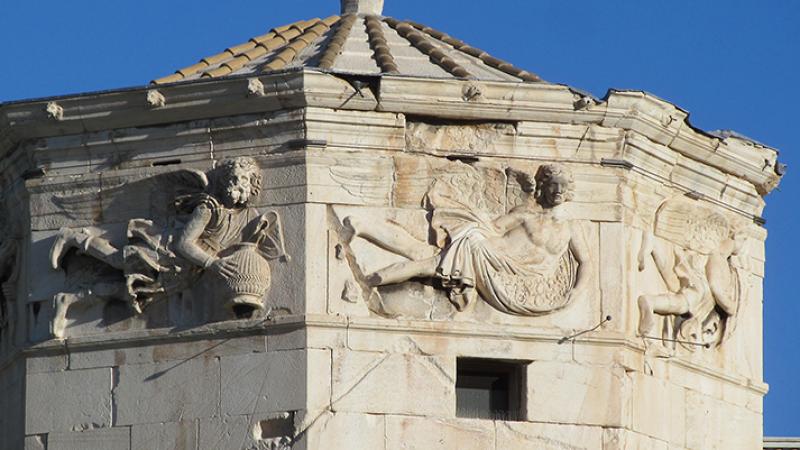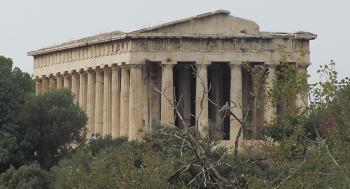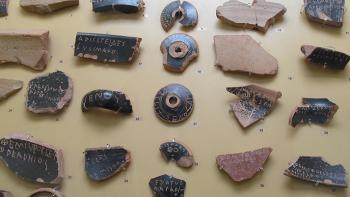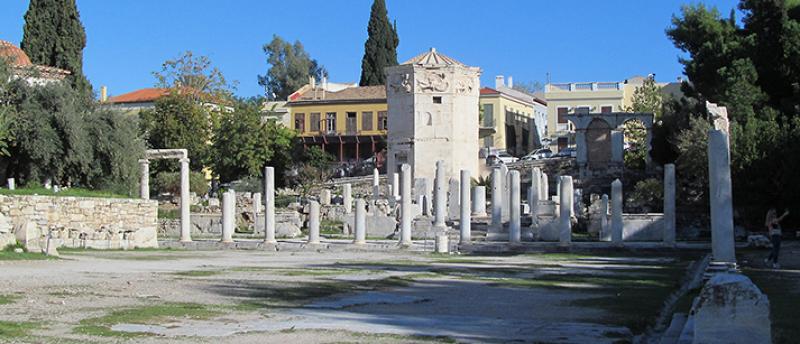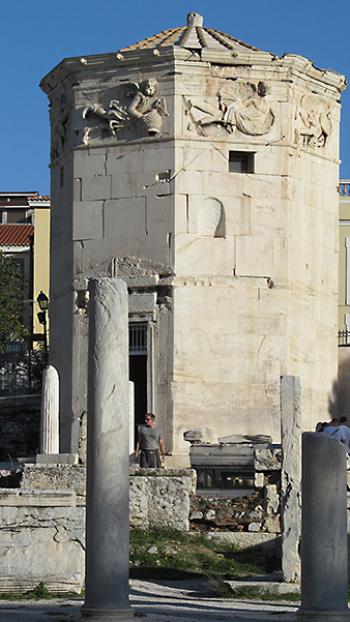Agora: crossroads of ancient Athens
This item appears on page 21 of the March 2022 issue.
I’m standing at the entrance to the Athenian Agora (Adrianou 24; phone 30 210 321 0180 or 0185) in Athens waiting for my husband, Paul, to pay for our entry tickets. The line on this sunny afternoon in October 2021 is unexpectedly long.
As I wait, I notice a small group of tourists also waiting while their guide stands in the ticket line. As they chatter away in English, one of the agora’s guards sidles over to them offering a bit of advance information preceding their visit. I sidle over too, doing my best to overhear without seeming to.
“You see over there,” he says, pointing upward to just beyond the agora. “That’s the Acropolis. If you haven’t been there yet, you will before long. That’s where the goddess Athena’s gold-and-ivory statue used to stand inside the Parthenon. She was the protectress of ancient Athens. But here, right in front of you,” sweeping his arms in a 180-degree arc over the site lying before us, “is where the Athenians of two-and-a-half thousand years ago lived. This is where they came to shop, conduct their legal business, visit a temple, meet friends, maybe even pick up tickets for a concert.”
Here he was cut short by the arrival of the group’s guide brandishing admission tickets. The guard’s few words captured for me the essence of this Greek agora. This was where much of everyday life in ancient Athens happened.
Nowadays it requires imagination, since what you see are ruins and foundations of buildings, with only a few structures standing out intact from the piles of rocks, among them the Stoa of Attalos and the Temple of Hephaistos.
History
This area beneath the Acropolis has been inhabited probably from at least the fourth millennium BC, but from about the 6th century BC, it developed into the heart of ancient Athens, an agora, or gathering place for all types of activities — governmental, legal, commercial, social, religious, educational, cultural. It must have been a beehive of activity. The ruins of the structures that litter the site testify to this.
After being destroyed during the Persian invasion of 480 BC, Athens, along with its agora, rose from its ashes during the city’s Golden Age that followed, was sacked by the Romans in 86 BC, fell to an invasion of the Heruli, a Germanic tribe in AD 267, and then to successive attacks in the 4th, 5th, and 6th centuries AD until finally being all but abandoned following the Slavic assaults of the late 6th century AD.
As the small, English-speaking tour group headed right, Paul and I veered left along what had once been the Panathenaic Way. This pathway was once the agora’s main thoroughfare. It was also the processional route that began in Kerameikos cemetery (Jan. ’22, pg. 24) and wended its way through the agora and up the slope of the Acropolis each summer to honor Athena.
There was a Lesser Panathenaea each year and a Greater Panathenaea every four years.
Stoa of Attalos
The building we were headed for, the Stoa of Attalos, was originally built by King Attalos II about 150 BC. Attalos, who ruled Pergamon, now in modern Turkey, was not an Athenian but was educated in Athens and, in gratitude to the city, built this stoa, or covered portico. The stoa was destroyed by the invading Heruli in AD 267.
During the 1950s, the Stoa was reconstructed. It’s an impressive white-marble structure, two stories high, almost 400 feet long, with an exterior colonnade of Doric columns and an interior one of Ionic columns.
The shops that once lined the back of the stoa have now become the Museum of the Ancient Agora, which traces the history of Athens from its earliest days (4000-3000 BC) through Mycenaen rule, between 1600 and 1100 BC, up to the 5th-century-BC Golden Age and beyond.
Of special interest is a collection of small pottery shards, called ostraca, from the Golden Age. These were used as “ballots” in ancient Athens. Using these shards, Athenian citizens voted to banish those seen as threats to their city. Banishments usually lasted 10 years.
After leaving the Stoa of Attalos, we made a slight detour past remnants of a sturdy wall built after the attack of the Heruli to keep future invaders out. It is interesting to note that this wall incorporates parts of the Stoa of Attalos that the Heruli had previously destroyed.
Tucked away in a corner of the archaeological site is the Greek Orthodox Church of Agii Apostoli (Holy Apostles), built about the year AD 1000, when Athens was part of the Byzantine empire and the center of power was no longer Athens or Rome but Constantinople (present-day Istanbul).
Agii Apostoli is just one of the many Greek Orthodox churches dotting the city, although Agii Apo stoli is unique in having been built partially over an ancient nymphaion, a shrine dedicated to water nymphs.
Weave your way through the ruins of several unrestored stoa to the Odeion of Agrippa, a theater built around 15 BC as a gift to Athens from the Roman statesman Marcus Vipsanius Agrippa, who was a close friend of the Roman emperor Augustus Caesar. The Odeion was used primarily for music concerts and poetry recitals and could originally seat 1,000 people.
Of the six huge pillars of giants and tritons (tritons being half human, half fish) which stood at its entrance, three still remain, although they are considerably damaged.
Tholos
Continuing westward away from the Stoa of Attalos takes the visitor to the Tholos, one of the most unusual buildings in the Athenian Agora. This circular structure that once had a conical roof was where the executive committee of the larger body called the boule met. Adjacent to the Tholos stood the bouleuterion, the meeting place of the entire council. These two — the Tholos and the bouleuterion — were the administrative nucleus of this Greek agora.
Temple of Hephaistos
A few steps away stands the majestic Temple of Hephaistos, dedicated to the god of fire and metallurgy. Also called the Theseion, it was built in the second half of the 5th century BC, at about the same time the Parthenon was being constructed. It is one of the best-preserved temples in Greece.
Surrounded by Doric columns, the temple sits atop a platform high above the agora. Visitors can climb up for a peek inside and for a closer look at the sculptures in the metopes (spaces between the triglyphs on the facade).
By now, we had circled the entire area of the Greek agora that is open to visitors and found ourselves close to the entrance/exit of the site. I noticed that the guard who had earlier been doling out information was doing so again, this time to a group of German tourists.
Roman Agora
There is another agora that visitors should not miss visiting. It’s the Roman Agora (phone 30 210 324 5220), located at the intersection of Epaminonda and Dioskouron. Also called the Roman Forum, it’s about a 15-minute walk from the Greek agora.
After the Romans conquered Athens in 146 BC, they built their own agora at the end of the 1st century BC. It was a gathering place similar to the Greek agora. In 15 BC, an enormous gateway, the Gate of Athena Archegetis, was constructed with funds donated by Julius Caesar and Augustus Caesar, according to the inscription carved on the architrave above the columns. This gate led into a vast courtyard surrounded by columns.
The courtyard now lies almost empty, but at its far end is the remarkable octagonal Tower of the Winds. Dating from the 1st century BC (although some archaeologists claim it was built in the preceding century), the 42-foot-tall tower is adorned, near the top, with carved reliefs of the eight winds of the world in the form of winged angels. There’s one of an angel turning an urn upside down (rain is on the way) and another with a round shield (perhaps as protection against hailstones).
This is a good place to end your visit to two agoras both lying within the shadow of the Acropolis. There are numerous cafés along the route between the two agoras at which to reward yourself with a Greek coffee and baklava, especially along Adrianou Street, right outside the entrance/exit to the Greek agora.
If you go…
In Athens, the Greek agora is open daily from 8 to 8, April to September, 8 to 6 in October and 8 to 5 from November to March. The admission charge is €10 (near $11.30).
The Roman Agora/Forum is open daily 8 to 8, May to October, and from 8 to 5, November to April. Entry costs €8.

